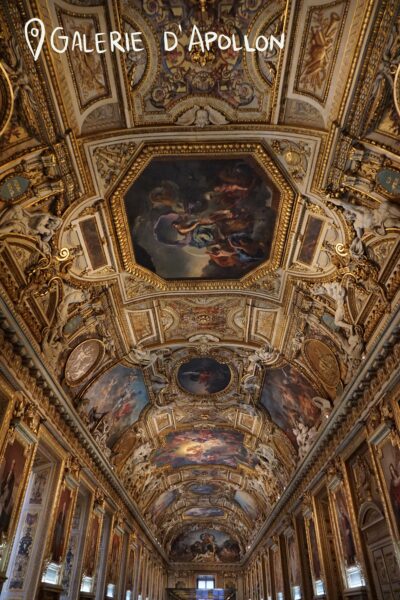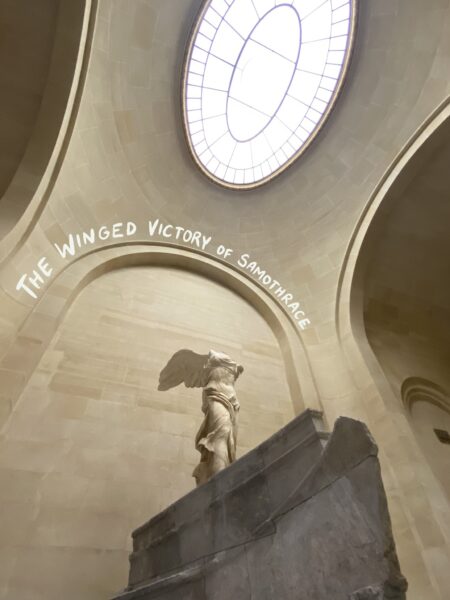Estimated reading time: 8 minutes
The Musée du Louvre, an iconic royal palace turned into the world’s largest museum, stands as a testament to the rich art history and cultural heritage of France. Situated in the heart of Paris, this magnificent institution attracts millions of visitors each year, making it the most-visited museum globally.
Whether you’re a passionate art lover or simply seeking to immerse yourself in the captivating world of masterpieces, a visit to the Louvre promises an unforgettable experience.
Table of contents
A little history and the impressive collections
Originally constructed as a fortress in the 12th century, the Louvre has undergone numerous transformations throughout its illustrious history. From serving as a royal residence to becoming a beacon of artistic expression, this iconic museum has witnessed the ebb and flow of French history. Today, it houses an impressive collection spanning from ancient civilizations to contemporary art, showcasing the boundless creativity of human expression.
The Louvre’s collection ranges from awe-inspiring sculptures like the Winged Victory of Samothrace and the Venus de Milo to legendary paintings such as Leonardo da Vinci’s Mona Lisa and Jacques-Louis David’s Coronation of Napoleon. Art enthusiasts can also marvel at the works of renowned masters like Eugène Delacroix, whose Liberty Leading the People captures the spirit of the French Revolution, and the poignant Death of the Virgin by Caravaggio.
Seeking the perfect picture?
Stay on the Louvre pyramid! To be honest, if you’re not very into art and are seeking the perfect shot to post, I would suggest to stay around the courtyard where the Louvre Pyramid is. It can get VERY crowded the later you go, hence, come early!
Another trick is to take pictures on the walkways around the pyramid, so that you can minimize the amount of people hanging around the background.
At night, the Louvre Pyramid also gets illuminated, which would make a very pretty picture.
Travel tip: You don’t have to pay the admission fee 😉

Ticket prices (how to get free admission?)
One of the main reasons for the long queues at the Louvre is the sheer volume of visitors it receives daily. To avoid wasting precious time in line, it’s highly recommended to book your tickets and time slots in advance through the official website or an online ticketing service. This way, you can bypass the crowds and gain direct access to the museum at your specific time.
Louvre tickets cost 22 EUR for general admission.
Tickets are FREE for youth below 18 years old and EU residents aged 18-25 years old. Proof of ID is required.
Free admission is available for all visitors every first Friday of the month after 6 pm. This is valid for all months except July and August.
You can find the official ticketing website here: Official Website.
Navigating the Museum: Tips for First-Time Visitors
With over 380,000 objects and a staggering 72,735 square meters of exhibition space, the Louvre can be an overwhelming experience for first-time visitors. To make the most of your visit, it’s essential to plan ahead and take advantage of the museum’s resources.
The Louvre is closed on Tuesdays and opens late on Wednesdays and Fridays. Here is their schedule:
Monday 09:00-18:00
Tuesday Closed
Wednesday 09:00-21:45
Thursday 09:00-18:00
Friday 09:00-21:45
Saturday 09:00-18:00
Sunday 09:00-18:00
When should I book?
One of the main reasons for the long queues at the Louvre is the sheer volume of visitors it receives daily. To avoid wasting precious time in line, it’s highly recommended to book your tickets and time slots in advance through the official website or an online ticketing service. This way, you can bypass the crowds and gain direct access to the museum at your specific time.
Book your time slot ticket WAY in advance, they sell out quickly! Preferably 1 month before your desired date for low season and 2 months prior for high season! (May to July)
When should I come to the museum?
While the Louvre is open every day except Tuesdays, the best time to visit is during the early morning hours or late afternoons on Wednesdays and Fridays when the crowds tend to be lighter. You still do have to elbow your way up to the Mona Lisa.
However, even during these times, you should still expect a significant number of fellow art enthusiasts. If you’re visiting on a public holiday or during peak season, it’s advisable to arrive as early as possible to beat the rush. Buy the time slot ticket straight from their official website HERE. I booked mine for 17 EUR.

Presently, the Louvre ticket came in the form of an eTicket, which you just have to show on your mobile phone. It is a timed ticket, so only come within 15-20 minutes of your timeslot. Otherwise, you’ll just be waiting outside for too long! They won’t allow you to queue if your timeslot is not called out yet.
There are four entrances to the Louvre Museum:
– Pyramid (Google Maps link)
– Carrousel (Google Maps link)
– Richelieu (Google Maps link)
– Porte des Lions (Google Maps link)
If you do not have a ticket, you can only enter through the Pyramid. Warning: it is ALWAYS super crowded!
However, if you do have a ticket on hand, you can enter through the Pyramid, Carrousel, and Porte des Lions on your chosen time slot. The Carrousel would be less crowded!
Travel tip: Evidently, the Porte des Lions entrance is closed every Friday and there is no locker. They can refuse your entry of you have large bags or helmets. Richelieu is only for groups or special pass holders.
I’m in the Louvre Museum. What now?
Great! Once inside the Louvre, you’ll be greeted by the iconic glass pyramid, a stunning architectural feat that serves as the main entrance. From here, you can explore the museum’s curatorial departments, each dedicated to showcasing specific eras, styles, and mediums.
Without a doubt, for first-time visitors, I would suggest you to follow the official trail recommendation from the Louvre to see their masterpieces. This trail covers the most sought after masterpieces of the Louvre:
– Venus de Milo
– The Winged Victory of Samothrace – my favorite sculpture <3
– The Mona Lisa (Leonardo da Vinci)
– Slaves (Michelangelo)
– Psyche Revived by Cupid’s Kiss (Antonio Canova)

Enhancing Your Experience: Audio Guides and Guided Tours
To truly appreciate the depth and significance of the Louvre’s collections, consider renting an audio guide or joining a guided tour. The museum offers multimedia guides in various formats, including the innovative Nintendo 3DS audio guide, allowing you to explore at your own pace while receiving insightful commentary.
It costs 6 EUR and you can get one at the ticket office right by the main entrance.
Alternatively, guided tours led by expert guides provide an immersive and educational experience, offering a deeper understanding of the museum’s history and the stories behind its iconic pieces of art.
Summary: Practical Tips for Louvre Museum
Before embarking on your Louvre adventure, there are a few practical tips to keep in mind:
- Free Admission: The Louvre offers free admission on the first Sunday of every month for all visitors, and every Friday evening after 6 pm (except in July and August) for those under 26 or holders of a valid ICOM card. Don’t forget to bring a valid photo ID to take advantage of these offers.
- Entrances: While the iconic glass pyramid is the main entrance, the Louvre has several other entry points, such as the Carrousel du Louvre and the Porte des Lions. The latter is often less crowded but may have restrictions on large bags or items for security reasons.
- Security Checks: Like any major attraction, the Louvre has strict security measures in place. Be prepared for bag checks and potential lineups at the security checkpoints.
- Lockers and Baggage: If you’re carrying large bags or items that may not be allowed inside, you can utilize the museum’s locker facilities or baggage storage services for a fee.
- Accessibility: The Louvre is accessible to visitors with disabilities, offering dedicated entrances, elevators, and amenities. Wheelchair rentals are also available on-site.
- Refreshments: With so much to explore, you’ll likely need to take a break. The Louvre offers various cafés, restaurants, and snack bars throughout the museum, providing a range of dining options to suit different tastes and budgets.
Beyond the Louvre: Exploring the Surrounding Area
While the Louvre itself is a magnificent destination, the surrounding area offers a wealth of additional attractions and experiences. After your museum visit, consider taking a stroll along the Seine River or visiting the nearby Tuileries Garden, a beautiful public park that once served as the gardens of the Tuileries Palace.
For those eager to continue their art exploration, the Musée d’Orsay, located just across the Seine, is a must-visit. This former railway station houses an impressive collection of Impressionist and Post-Impressionist masterpieces, providing a perfect complement to the Louvre’s classical and Renaissance works.
The Louvre: A Timeless Treasure in the City of Lights
Whether you’re a seasoned art connoisseur or a first-time visitor to Paris, the Musée du Louvre promises an unforgettable journey through the ages. From marveling at the enigmatic smile of the Mona Lisa to appreciating the intricate details of ancient sculptures, this iconic museum offers a gateway to the world’s cultural heritage.
So, plan your visit, immerse yourself in the rich tapestry of art, and create lasting memories in the heart of the City of Lights!
P.S. = Here is a list of the 13 works of art you should NOT miss while in the Louvre! Also check out art you should see in Musée d’Orsay 🎨


2 comments on “What You Need to Know: The Louvre Museum Paris Tickets”